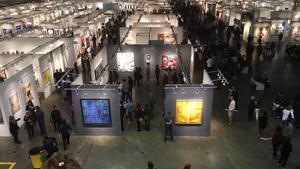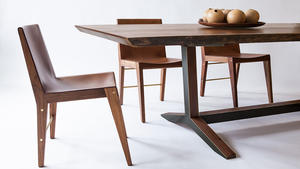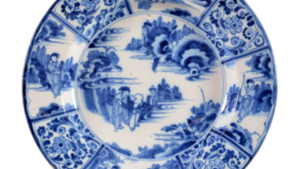Next week at the New York School of Interior Design, a retrospective exhibition titled Angelo Donghia: Design Superstar and 50-minute documentary, will pull back the curtain on the life and work of design icon Angelo Donghia (1935-1985), one of the most influential American interior designers of the 20th century. Acclaimed for his signature style, business savvy and celebrity client list, he revolutionized licensing for the home furnishings industry, with the Donghia name, and influence, placed on products from 20-plus fabric, furniture, tableware and accessories companies.
The exhibition, which opens September 17, chronicles the designer’s life, beginning with a stint at Parsons School of Design in 1958 and first job with decorator and antiques reproduction dealer Yale Burge, and traces the development of Donghia Associates. Curated by Donghia's creative director Chuck Chewning, it includes photographs, original renderings, furniture, textiles, archival materials and the documentary, with particular designs created for celebrities including Liza Minnelli, Barbara Walters, Diana Ross and Ralph Lauren. Gura, who collaborated with Chewning, says, "Chuck was a dream to work with. He has great vision, nonstop energy, and seems able to juggle a dozen things at once. His concept for the exhibition combines real furniture with images. It's going to be one of the most beautiful shows we have put on!"
The documentary, produced by Editor at Large, includes commentary from members of the original Donghia Associates design team, close friends such as writer/director Joel Schumacher and Architectural Digest's Paige Rense, as well as never-before-seen video interview footage of Donghia himself from 1979.
Robert L. Greene interviews Angelo Donghia. Courtesy FIT General Oral Histories, 1979, Angelo Donghia interview, Fashion Institute of Technology|SUNY, FIT Library Special Collections and FIT Archives
Chewning says the original idea came about eight years ago but was tabled until recently, due to the recession. He realized that “No one has produced a book or exhibition about the life of Angelo Donghia, who contributed so significantly to the design industry as we know it today.” Some of the most interesting research findings include original watercolors from the designer’s student days—“They illustrate a very classical, traditional training that Angelo beautifully executed but show little of the modern, edited Angelo we would come to know,” notes Chewning—as well as a series of taped interviews produced at the Fashion Institute of Technology with Robert L. Green and Stanley Barrows that “give enormous insight into his thinking about design and business.” Editor at Large president and documentary director Julia Noran Johnston used the interviews as a “narration” for the film. “I was amazed by the depth and breadth of the Donghia archives. The quality and quantity of documentation—family photographs from the 1930s and 1940s, school projects with grades and notes from teachers, invitations, newspaper and magazine clippings—all lovingly preserved, organized and woven together to form this story of his life,” she shares.
Chewning feels that one of the most significant projects was Donghia’s 71st Street townhouse. “I love the recreation of [its] living room with Viridian green walls, the Bristol sofa, the slipper chairs, Richard Giglio painting and, most importantly, the pair of chinoiserie screens Angelo purchased from the estate of Coco Chanel,” says Chewning. The home was also among the most-referenced projects by Johnston’s interviews. “Paige Rense, the former editor in chief of Architectural Digest, said that winning that project for Architectural Digest magazine was a turning point in her career, and made the magazine what it is today,” says Johnston.
The documentary explores Donghia’s relationships, both business and personal, with interviews from Ann Sonet, Masaru Suzuki, Mario Buatta, Mel Dwork, Ronald Bricke, John Boone, Paige Rense and Joel Schumacher. “As a businessman, people described him as a visionary, someone who knew what he wanted and wasn't afraid to go after it. As a friend, he was loyal and nurturing,” reflects Johnston. “One aspect of his life that didn't make it into the film was his close relationship with his mother, who moved to Manhattan when her husband, Angelo's father, died. Angelo set her up in a gorgeous apartment, took her to parties, and made her part of his world. All of his friends knew her and loved her.”
The designer’s legacy continues to impact the design industry decades after his death from AIDS in 1985 at age 50. “He was the first to create a multi-faceted business in the interior design space—he had six companies (fabric, furniture, contract, residential, and licensing), not to mention a huge staff and demanding client list. He was paving the way for his contemporaries and future generations,” says Johnston. “So many big-name designers got their start at Donghia, and refer to him constantly, even today.”
Judith Gura, NYSID professor of design history and theory, consulted on the exhibit and also wrote the catalogue. She explains its timeliness of the exhibit, and Donghia's impact on today's students. "Students can learn that you can take different paths to build a design career, and that designing beautiful rooms may involve breaking rules and mixing styles," she shares. "We wanted to host the exhibition to honor Angelo, and to make him known to a new generation that knows the Donghia companies but doesn't know about the person behind them."
The exhibition and documentary will be on view through December 5 at the New York School of Interior Design, 161 East 69 St. Learn more online.




























